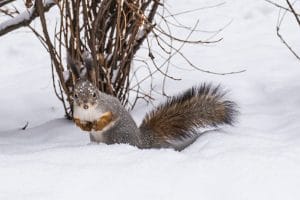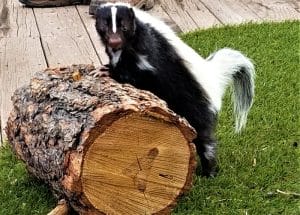There are over 20 species of squirrels in Canada, and we typically split them into three categories: tree squirrels, ground squirrels, and flying squirrels. Setting aside the more recognizable flying species for a moment, most non-specialists have difficulty spotting the difference between tree and ground squirrels.
This makes sense, because both types have bushy tails and fluffy fur, and both eat an omnivorous diet of fruit, nuts, and insects. The names give away the most notable difference: tree squirrels prefer to make homes in trees, and ground squirrels prefer the ground. However, tree squirrels can complicate the matter because they don’t only make their homes in trees! So what other characteristics can we use to tell the two apart?
The Tree Squirrel
Here in Ontario, there are two common species of tree squirrel: the Eastern Gray Squirrel (by far the most common) and the American Red Squirrel. The Eastern Gray isn’t only gray; they may also have brown or, notably, black fur and can measure about 40 to 50 cm long (including the tail). Red squirrels are smaller, growing up to 21 cm.
Tree squirrels are active year-round, meaning they can cause damage year-round, too. Tree squirrels stash supplies to carry them through winter, spending the days approaching the cold foraging and hiding food. One common spot is the cozy warmth of your home, and tree squirrels enter homes through attics and chimneys to make a nest or stash food. Once inside, the squirrels can gnaw on insulation, electrical wiring and structural materials.
It’s important to humanely remove tree squirrels as soon as you detect them in your home. On top of the structural damage, they carry parasites that can spread elsewhere in your home. If you let them nest for too long, their babies can grow and cause even more damage!
The Ground Squirrel

While a tree squirrel could burrow, most species of ground squirrel won’t climb into a tree. They prefer grassy, open fields on which to find food and build their complex dens. Their complex burrows go into the ground as far as four feet, and they like forming underground networks where multiple ground squirrel families can interact, stay safe, and hibernate. Unlike tree squirrels, ground squirrels sleep in these dens throughout the winter.
Even though there are 16 species of ground squirrels across Canada, they aren’t common in Ontario. There’s a close relative to the ground squirrel in our province that can become an unwanted guest: the chipmunk. These rodents can grow up to 20 centimetres and usually stay outside of homes, preferring to burrow under patios, in gardens, and among other man-made spots. They can also wreak havoc among vegetable gardens and ornamental plants, so homeowners should evict chipmunks to prevent this damage.
What About Flying Squirrels?
Ontario is also home to two species of flying squirrels: the northern flying squirrel and the southern flying squirrel. They’re pretty easy to tell from the others: they have brown backs, white bellies, with a skin fold along the flanks and attached to the feet that lets this squirrel glide among the treetops. The northern species can get as big as a red squirrel, with the southern species roughly the size of a chipmunk.
The two species of flying squirrels are pretty rare, but they are making a comeback as we preserve and rehabilitate their forest homes. Like tree squirrels, flying squirrels most often make their homes in high places and can find spaces in attics and chimneys.
What If There’s A Squirrel In My Home?
It’s always good to know what species of squirrel your wildlife eviction specialist will be dealing with so they can resolve the situation as quickly as possible. However, we understand that getting a good look isn’t always possible, especially if they’re in your chimney or attic. If you’re in the Bad Company service area, the most likely culprit for those noises you hear or the damage you see is an Eastern Gray Squirrel.
Our team understands squirrel biology and behaviour, and we can anticipate how a squirrel will behave. Don’t handle them yourself: on top of being very unpredictable, squirrels can spread disease and get nasty when cornered. Leave their eviction to the professionals!



